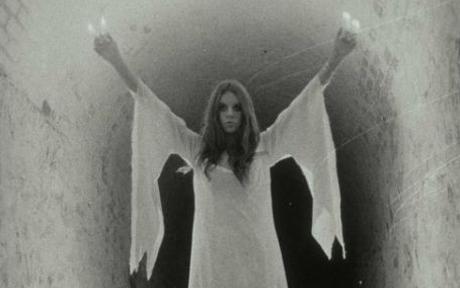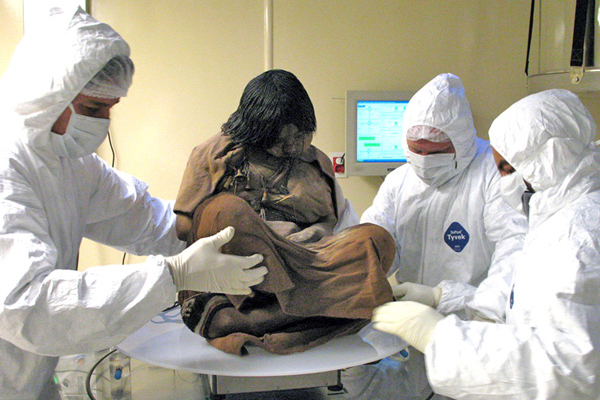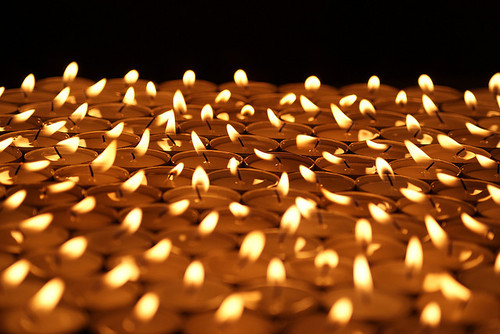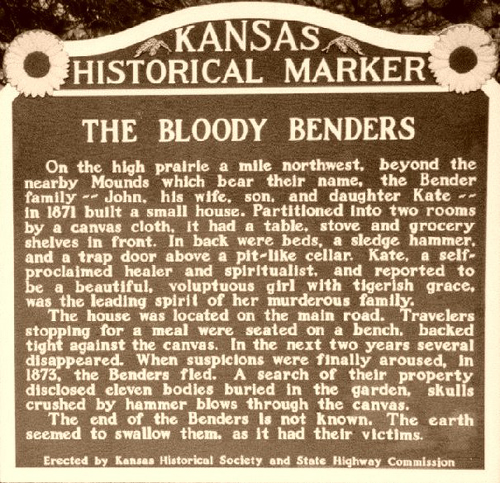
In
popular medieval legend, a White Lady is fabled to appear by day as
well as by night in a house in which a family member is soon to die.
According to The Nuttall Encyclopaedia, these spirits were regarded as
the ghosts of deceased ancestresses.
Castle Huntly, Scotland, is said to be haunted by a young woman dressed
in flowing white robes. There are various stories concerning her
history, one of which is that she was a daughter of the Lyon family who
occupied the castle in the 17th century. When her affair with a
manservant was discovered she was banished to a tower on the
battlements. Unable to endure her suffering, she threw herself to her
death from the tower. The ghost of the White Lady has been seen a number
of times over the years, often on the grounds surrounding the castle.
She has also been seen in the room in which she was imprisoned.
Darwen is reportedly haunted by a ghost. In Darwen's old cemetery there is a gravestone of a supposed white lady,
whose eyes open when they are touched. There have been reported
sightings of her ghost walking around the area at night, seeking her
child. The white lady of Darwen is said to have died during childbirth,
or to have been raped and murdered by a group of men who stole her
child. She is said to manifest in response to the spoken phrase "White
lady, white lady, I stole your black baby", before attacking the speaker
and causing them to faint. Local folklore says that the white lady of
Darwen killed a group of teenagers who were on a camping trip in the
White Hall Park in the late 1980s, within two hours of them visiting her
grave.
The White Lady of Willow Park is native to a small,
heavily-wooded park of Newton-le-Willows, Merseyside, in northwest
England. She is thought to be the tormented spirit of a bride who was
drowned in the lake by her husband on their wedding night. Variations on
her method of death include being bricked up in a cave and hanging
herself in the kitchen.
Urban Legends of White Lady Ghost

Initially
this might look to you like any normal girl being treated by a
doctor,the girl in the photo is not any normal living girl but the mummy of a 15 year old child who has been dead for about 500 years.
She was found in 1999 near Llullaillaco's 6739 meter summit. An
Argentine-Peruvian expedition found the perfectly preserved body and she
was nicknamed "La doncella" which means “The maiden”. According
to the Inca she was chosen to go and live with the gods. But in reality
she was a sacrifice to the Inca Gods and had been brutally killed in the
name of religion.
Scientists say that her organs are intact and its as if she had died
just a few weeks ago. From testing the samples of her hair they could
determine the type of diet she was on before her death. This lead to the
discovery that the Incan fattened their children before killing them.
Months or even years before the sacrifice pilgrimage these children were
given diets which were those of the elite, consisting of maize and
animal proteins.
Judging from the condition of the body, it is believed that she was
drugged and left to die in the mountains. It would not have taken much
time for her to die due to the high exposure. The Incan high priests
took their victims to high mountaintops for sacrifice. As the journey
was extremely long and arduous, especially so for the younger victims,
coca leaves were fed to them to aid them in their breathing so as to
allow them to reach the burial site alive. Upon reaching the burial
site, the children were given an intoxicating drink to minimize pain,
fear, and resistance, then killed them either by strangulation, a blow
to their head or by leaving them to lose consciousness in the extreme
cold and die of exposure.
Mummy Juanita - Inca Girl Frozen For 500 Years

The
game was played as night fell upon the region using three separate
rooms. In preparation, participants would light 100 andon in the third
room and position a single mirror on the surface of a small table. When
the sky was at its darkest, guests gathered in the first of the three
rooms, taking turns orating tales of ghoulish encounters and reciting
folkloric tales passed on by villagers who claimed to have experienced
supernatural encounters. These tales soon became known as kaidan. Upon
the end of each kaidan, the story-teller would enter the third room and
extinguished one andon, look in the mirror and make their way back to
the first room. With each passing tale, the room slowly grew darker and
darker as the participants reached the one hundredth tale, creating a
safe haven for the evocation of spirits.
However, as the game reached the ninety-ninth tale, many participants
would stop, fearful of invoking the spirits they had been summoning.
While the exact origins of Hyakumonogatari Kaidankai are unknown, it was
believed that it was first played amongst the samurai class as a test
of courage. In Ogita Ansei's 1660 nursery tale "Otogi Monogatari" a
version of the game was described in which the narrative tells of
several young samurai telling tales in the Hyakumonogatari Kaidankai
fashion. In the tale, as one samurai finished the one hundredth tale, he
began to extinguish the candle when suddenly he sees a giant gnarled
hand descend upon him from above. While some of the samurai cowered in
fear, a swipe of his sword revealed the hand to be merely the shadow of a
spider.
At first, the game of Hyakumonogatari Kaidankai was popular amongst the
aristocratic warrior class, but it soon garnered favorable reputation
amongst the working class peasants and town people. With a heightened
interest in telling newer and original kaidan, people began scouring the
countryside for tales of the mysterious, many of which combined a
mixture of ghostly vengeance and elements of karma in Buddhism.
Japanese culture and heritage are rich with spirituality and
superstition. In Japan, you should "cleanse" yourself after going to a
funeral by throwing salt over your body. Cutting your fingernails in the
evening is bad luck, and so is using or referring to the number four
(homonym for death) or nine (homonym for suffering). However, few
practices are quite as fascinating as the 100 ghost stories game. This
was a popular parlor game called Hyakumonogatari Kaidankai, from the Edo
period (1603 - 1868). It worked as follows:
Urban Legend of 100 Candles Game - Hyakumonogatari Kaidankai

The
Bloody Benders were a family of serial killers who owned an inn and
small general store in Labette County of southeastern Kansas from 1871
to 1873. The family consisted of John Bender, his wife Mrs. Bender
(later referred to as Kate, Sr., since no one knew her given name), son
John, Jr., and daughter Kate. While Bender mythology holds that John and
Kate were brother and sister, contemporary newspapers reported that
several of the Benders' neighbors have stated that they claimed to be
married, possibly a common law marriage.
They are believed to have killed about a dozen travelers before their
crimes were discovered and the family fled, with their fate uncertain.
Much folklore and legend surrounds the Benders, making it difficult to
separate fact from fiction.
Background
Following the American Civil War, the United States government moved the
Osage Indians from Labette County, Kansas to a new Indian Territory
located in what would eventually be Oklahoma. The newly-vacant land was
then made available to homesteaders. In October 1870, five families of
spiritualists settled in and around Osage township of western Labette
County, approximately 7 mi (11 km) northeast of where Cherryvale would
be established seven months later. One of the families was John Bender
Sr. and John Bender Jr. who registered 160 acres (65 ha) of land located
adjacent the Great Osage Trail, which was then the only open road for
traveling further west. After building a cabin, a barn with corral and a
well, in the fall of 1871, Kate (Ma) Bender and her daughter Kate
arrived and the cabin was divided into two rooms by a canvas
wagon-cover. The Benders used the smaller room at the rear for living
quarters, while the front room was converted into a "general store"
where a few dry goods were sold. The front section also contained their
kitchen and dining table, where travelers could stop for a meal or even
spend the night. Ma and Kate Bender also planted a 2 acres (0.81 ha)
vegetable garden and apple tree orchard north of the cabin.
Bender family
John (Pa) Bender Sr. was around sixty years old and spoke very little
English. When he did speak it, it was so guttural that it was usually
unintelligible. Ma Bender, who also allegedly spoke very little English,
was 55 years of age and was so unfriendly that her neighbors took to
calling her a "she-devil". John Bender Jr. was around 25 years old,
handsome with auburn hair and mustache and spoke English fluently, but
with a German accent. John was prone to laughing aimlessly, which led
many to consider him a "half-wit". Kate Bender, who was around 23, was
cultivated and attractive and she spoke English well with very little
accent. A self-proclaimed healer and psychic, she distributed flyers
advertising her supernatural powers and her ability to cure illnesses.
She also conducted séances and gave lectures on spiritualism, for which
she gained notoriety for advocating free love. Kate's popularity became a
large attraction for the Benders' inn. Although the elder Benders kept
to themselves, Kate and her brother regularly attended Sunday school in
nearby Harmony Grove. The Benders' inn was a simple one room house
divided into living quarters and the kitchen and store area.
The Bloody Benders: Horror in the Old West




